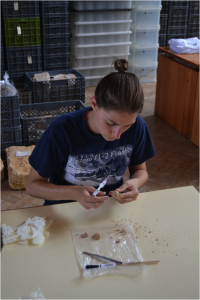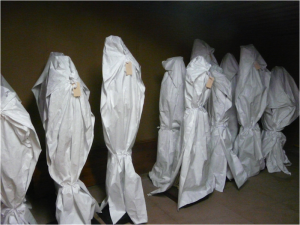What is your scientific background?
I consider myself a human biologist – one of a group of researchers interested in discovering the range of human biological variation and understanding what factors influence that variation. Specifically, I study the skeleton in both archaeological and forensic settings.
My undergraduate training is in anthropology and history, and my graduate training is in a department of archaeology. It might seem like a weird set of influences, but I actually see a little of all of these fields reflected in my work. In anthropology, I learned about all kinds of societies and their diverse cultural practices. In history, I learned to think critically. In archaeology, I learned about human evolution, dispersal, and development of societies over the last several million years.
Which topic are you working on at the moment? Why did you choose this topic and how do you think you’ll make a difference?
Right now, I am fascinated by the process of childhood growth. All adults were once children, and I think a significant portion of human anatomical variation stems from this period. Nearly all of the projects I am working on now relate to children.
Another topic lies at the core of many of my projects – the idea that poor socioeconomic conditions have negative health and growth impacts early in life, which can have serious repercussions later in life. Although I’m working on this issue in past populations, it is relevant in modern populations as well. To me, if we’re serious about giving all children an equal chance to thrive, we need to get serious about fighting poverty both at home and abroad.

What is a typical day like for you?
One of my favourite parts about my work is that it is never monotonous. Some days might involve teaching, others might involve data collection in museums abroad, analysis at home or in the lab, archaeological digs, preparing presentations, reports and articles, organizing research events, and many other tasks.
When travelling for data collection, I am generally taking measurements and x-rays of human bones and teeth in dark, dusty corners of museums around the world. One time, I worked in an attic with dim lights. The skeletons were mounted, like a demonstration skeleton you might see at a doctor’s office, and then covered by a white sheet. Every time I turned around, that group of skeletons startled me!
Now, I’m starting a project in which I am reconstructing medical CT scans in 3D. It means less travelling, but at least my lab is bright and sunny!
What are the hardest parts related to this work?
There are a few difficult things about my work. One of those is that it requires a lot of writing: grants, proposals, ethics approvals, presentations, papers, etc… The other is linked to doing research in forensic anthropology, because we are dealing with death. One project required me to read through a files related to fatal accidents and homicides of children aged from birth to 18 years. It was sometimes hard to read the circumstances of the death, but I think that the results of the project have been worth it.
Is it hard to manage both career and private life? How do you manage both?
One of the hardest parts of academic work is that you are not completely in control of either your location or your program of work. Because research positions and funding are not growing in proportion with the increase in students completing research degrees, competition for resources can be fierce. Part of that is a fun challenge: where in the world will you end up working? What research projects can you pursue that will be meaningful for others? Unfortunately, it means balancing your career and your personal relationships with friends, family, significant others.
It’s not always easy. Lately, I’ve come to accept that it’s impossible to be completely focused on both at the same time. During some periods, sometimes weeks or months, my days center on research. Even at home, I sometimes cannot get my thoughts off of the topics I am working on in the lab. This can make me a distracted listener, so during those periods I tend to spend less time at home or with friends. And during other periods, I put science on the back burner and dedicate myself to catching up with my loved ones. Sometimes, I don’t even read a research article for weeks! These cycles come naturally to me, and they are essential to refreshing my mind and keeping my relationships strong. I guess I have realized that multitasking is not my strong suit.

Besides your scientific interests, what are your personal interests?
Like many other academics, I am a fan of endurance sports. Last year, I finished my first 50km trail running race – since it was in the mountains, it took me just shy of 8 hours!
What I didn’t expect when I started long distance running is that it would give my brain the time to think through any problems I was facing in my research. Many of my best ideas were born on the trails surrounding my university. I also like to rock climb – it’s a completely different kind of sport which helps me work on my focus.
Outside of that, I really enjoy reading pretty much anything about humans. I follow a number of blogs (for example Sapiens.org). When something catches my interest, I do some background research about the topic and sometimes blog about it myself.
Right now, I’m reading Sapiens by Yual Noah Harari, and Robert Sapolsky’s new book Behave is up next. I have to admit that I also read a lot of fiction: I just finished Half of a Yellow Sun and Purple Hibiscus by Chimamanda Ngozi Adichie, who is a phenomenal storyteller.
If you had the option to give advice to a younger version of yourself, what would that be?
Don’t worry so much. Work hard, of course, but enjoying life is just as important. Somehow things have a way of working themselves out.

In your opinion, which changes, if any, are needed in the scientific system to be more attractive to female scientists and possible future scientists?
One thing I’ve been thinking about is the time it takes between finishing a PhD and getting a first permanent position. In many fields, because the job market has been so difficult in the last decade, this is rising to 5-10 years, and requires long distance moves to take contracts lasting 2-3 years at most. This kind of lifestyle, combined with other obstacles women face in job competitions, can dissuade women from pushing onwards. If we want to increase female representation in university faculty, I firmly believe departments need to start thinking about hiring early career scholars a few years out of their Ph.D.
You can contact Laure at lspake@sfu.ca and follow her on Twitter!




